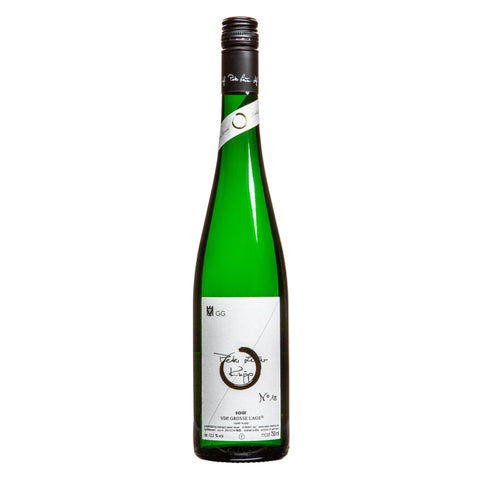
2023 Peter Lauer "Kupp" No. 18 Riesling Grosses Gewächs, Mosel, Germany
This ‘Grand Cru’ varietal Riesling is textured, luscious, and fruit-forward, marked by serious spice undertones and a and lively fruit and and stone-elegance, with a great future in the cellar.
ABOUT THIS WINE
In 1956, grandfather Peter Lauer I cultivated the best part of Ayler Kupp from a newly acquired parcel that belonged to the Notar Tappen-Mungenast winery in Saarburg. With a gradient of 70 percent, this is the steepest and warmest part of the hillside. The grapes are correspondingly ripe and so is the acidity. The now 65-year-old vines have an impressive age and have found their balance. The yield is low, and the quality is therefore excellent. The dry Kupp GG inspires with its fine spicy slate flavor and lively fruit.
ABOUT THIS PRODUCER
Riesling is our passion at Weingut Peter Lauer. Our wine estate in Ayl has among the best steep slopes on the Saar. In addition to the famous Ayler Kupp, we cultivate two other important vineyards in the Mosel region: the Saar Feilser directly above the river and the steeply sloping vineyard Schonfels, a little farther upstream. Recently, we also replanted and recultivated the now forgotten Lambertskirch, just a stone’s throw from Schonfels.
Our white wines have been among the best in the Saar for many years. Since 2013, we have been a member of the VDP (Association of German Prädikat Wine Estates). Our wines from VDP.GROSSEN LAGEN® in the dry and off-dry styles are particularly special. We also produce exceptional sparkling wines.
Each cask corresponds to a distinctive style and a special point of origin. The must from specific vineyards is always vinified in the same container as the previous year. The cask is thereby unique.
The wild yeast flora inside the cask “hibernates” in the fine fibers of the wood and ferments the same site again in a style comparable to its predecessors. According to grandfather’s custom, all wines are given this number – the house number in the old vaulted cellar.
Our wines are vinified according to age-old artisanal and traditional winemaking practices and fermented spontaneously without genetically modified or cultured yeasts. The vineyards serve as the source of these wild yeasts. But the cellar is also home to natural flora.
On the way to a great authentic wine, both sources are involved and leave their characteristic fingerprint – the yeasts of the vineyard and those of the cellar.
It was over 100 years ago that Saar wine had a mythical reputation – it was twice as expensive as wine from Bordeaux and Burgundy. A good bottle cost 15 marks (Goldmarks) and more. That would be one or two months’ wages today. The oldest vineyard classification in the world from 1832 testifies to the importance of viticulture on the Saar at that time. This historical viticultural cadastre describes the world’s most exclusive and valuable vineyards of the 19th century. At this time, great-great-grandfather Matthias laid the foundation for a 180-year-old tradition.
